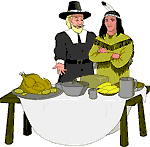In the fall of 1621, 90 Wampanoag Indians and 52 English colonists gathered for a three-day harvest feast. How did Americans get from that celebration to the Thanksgiving 'traditions' we observe today?
By Elizabeth Armstrong
1. The first Thanksgiving was a harvest celebration in 1621 that lasted for three days.
2. The feast most likely occurred between Sept. 21 and Nov. 11.
3. Approximately 90 Wampanoag Indians and 52 colonists--the latter mostly women and children--participated.
4. The Wampanoag, led by Chief Massasoit, contributed at least five deer to the feast.
5. Cranberry sauce, potatoes--white or sweet--and pies were not on the menu.
6. The Pilgrims and Wampanoag communicated through Squanto, a member of the Patuxet tribe, who knew English because he had associated with earlier explorers.
7. Besides meals, the event included recreation and entertainment.
8. There are only two surviving descriptions of the first Thanksgiving. One is in a letter by colonist Edward Winslow. He mentions some of the food and activities. The second description was in a book written by William Bradford 20 years afterward. His account was lost for almost 100 years.
9. Abraham Lincoln named Thanksgiving an annual holiday in 1863.
The Surprising First Thanksgiving Menu--No Turkey, No Pumpkin Pie?
By Karla Reed
In addition to the wild fowl, pumpkin and squash mentioned above, the following foods were certainly abundant and most likely were included in the “harvest” celebration:
1621 Thanksgiving Meal Details


No comments:
Post a Comment